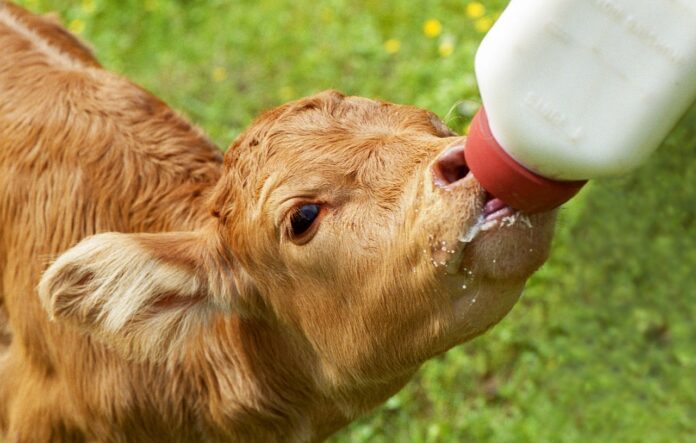Colostrum intake is perhaps the single most important meal in a newborn calf’s life. Beef and dairy calves are born without immunity and the first colostrum meal right after birth provides the protection, immunoglobulins — IgG — and other vital nutrients needed to survive and grow.
In cattle, colostrum production begins several weeks before calving, and its composition, e.g., IgG, is influenced by the feeding, environment and management practices used for dry cows. Below are a few practical steps when it comes to harvesting and feeding quality colostrum.
Keep an eye on hygiene and cleanliness. Using the same protocol for milking, sanitizing the cow’s udder and teats reduces bacterial contamination while stimulating colostrum let-downs. When pasteurizing colostrum, it should be performed at 140°F for 60 minutes. The proper refrigeration temperature is 40°F and could be stored frozen at -4°F using 2.5 gallon bag containers to ensure a quick thaw-out process.
Colostrum should be thawed out at 104°F and fed right away at 101-104°F. Daily cleaning and sanitation of buckets, bottles, nipples and esophageal tubes are equally important.
Why is hygiene so important? Because feeding newborn calves with contaminated colostrum, E. coli and other pathogens, is directly associated with increased calf mortality. Here are five steps for cleaning and sanitation:
- Rinse the bucket/bottle/nipple/tube with cool water, about 90˚F.
- Soak in hot water, 140°F with 1% chlorinated alkaline detergent.
- Wash with hot water, 145°F. Use a brush to break up fat particles from colostrum and/or milk.
- Rinse with cold water.
- Disinfect following directions for commercial disinfectant and allow feeding equipment to dry thoroughly.
Avoid using the pressure washer when sanitizing the maternity. Pressure washers should not be used as Salmonella and other pathogens can be aerosolized and transmitted to people and animals. The maternity should provide a thermoneutral, clean and dry environment.
How much colostrum should newborn calves be fed? As a rule of thumb, newborn calves should be fed 10-12% of their birth body weight, BW. For instance, an 80-pound calf would need to be fed one to 1.2 gallons of quality colostrum.
What is the appropriate timing for colostrum harvesting? The first one to two hours after calving would provide optimum colostrum volume and quality, in terms of IgG concentration. For Holsteins, colostrum yield at first milking should be at least one gallon for first-calf heifers, and two gallons for multiparous cows. For Jerseys, colostrum yield at first milking should be at least one gallon for first-calf heifers and 1.2 gallons for multiparous cows.
When colostrum volume is lower than expected at first milking, wait four more hours and repeat milking. Animal handling and positive animal-people interactions — being calm and patient — promote the let-down process and increase the colostrum volume harvested.
Do cows recognize an aversive handler? Yes, and this interferes with oxytocin release. Is milk or colostrum yield reduced with an aversive handler? Yes, by three to four pounds per milking.
How soon after birth should colostrum be fed to newborn calves? Keep in mind that absorption of IgG at the calf’s intestinal level decreases by 3.7 percentage points for every hour after birth. Therefore, the first colostrum meal should be fed within one hour of birth.
- 1st feeding (8% calf BW): ~0.84 gallons within one hour of birth.
- 2nd feeding (4% calf BW): ~0.4 gallons at six hours after administration of first meal.
What is the optimum colostrum quality for newborn calves? Colostrum quality is determined by the IgG concentration and bacterial contamination. Newborn calves should be fed colostrum with IgG concentration >50 mg/mL IgG or ≥23% Brix. Under field conditions, this could be accomplished by using a digital refractometer, Brix, to determine the concentration of IgG.
To avoid variation in Brix values, both colostrum samples and digital refractometer should be at 68°F. What is the effect of extending colostrum feeding? New studies have shown that feeding 100% colostrum on day one, followed by feeding a 50/50 milk with colostrum blend for days two and three and then from days four through 15 feeding a blend of 90% milk and 10% colostrum promotes calf health and growth.
About 50% of fetal growth occurs during the last 60 days of gestation; therefore, the dry cow period is critical for the survival, health and growth of newborn calves. The first colostrum meal, which is required for calf survival and health, is influenced by adequate dry cow management and housing, careful animal handling and hygiene practices. An ounce of prevention is worth a pound of cure. Please have this discussion with your veterinarian and nutritionist. These little details make the difference at the end of the day.













